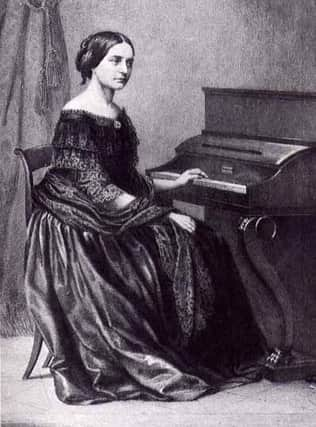Tale of the talking piano that sailed from Germany to Irealnd in 1862


Distributed by Capitol Records on a 10-inch, 78-RPM record, the immensely popular story was about a little boy called Sparky who detested practising the piano.
Suddenly Sparky’s piano started talking with a twangy, echoing voice, persuading the flabbergasted lad to run his fingers over the keyboard.
Advertisement
Hide AdAdvertisement
Hide AdWonderful classical music emerged from the piano and young Sparky became a musical marvel, performing to amazed audiences in the world’s leading concert halls.
The magic ended suddenly during a packed concert in New York.
No matter how hard Sparky thumped the keys the piano didn’t respond.
The music had died.
Then Sparky woke up!
The entire experience was a dream but he vowed to keep practising until he could play as well as he did while he slept.
Advertisement
Hide AdAdvertisement
Hide Ad“So, here I am! Yes, I am an old piano now, but I was once young and new. I would like to tell you my story.”
Thus speaks another piano, at the start of a book called ‘Tales of a Travelled Piano’ written by Elisabeth Goell, a Dutch-German soprano and piano teacher living in Omagh, County Tyrone.
It’s a fascinating ‘first-person account’ of Clara Schumann’s piano - spoken, as to Sparky, by the piano itself - vividly describing its journey from Germany to Donegal and its role in the cultural life of 19th century Ireland.
The piano’s gripping and historic tale is woven with excitement and danger, fame and fortune, tragedy and poverty.
Advertisement
Hide AdAdvertisement
Hide AdThe instrument survived a long and arduous sea journey in 1862 “by steamboat from Dresden via the Elbe Canal to Hamburg… then the North-Sea and across the Irish Sea.”
The piano can’t recall whether it disembarked in Londonderry or Donegal after the long sea-voyage - “I was too shook up to remember where I had stepped on land.”
It was taken by horse-drawn carriage to Convoy House, in the village of Convoy, County Donegal, home of the Montgomery-Boyton family, its new owners.
The piano was greatly impressed with their stately mansion!
“It was quite a sight to see, coming through the gates and up the drive before being installed in the grand drawing room of the house.”
Advertisement
Hide AdAdvertisement
Hide AdThe piano experienced the tragedies of the Irish famine and the luxuries of ‘high society’.
Its previous owner Clara Schumann, wife of the acclaimed composer Robert Schumann and life-long friend of Chopin, was a celebrated 19th century German pianist and composer whose portrait adorned her country’s 100 Deutschmark note.
Born in 1819 in Leipzig, Clara was below the legal age of 21 when she married Robert and when she announced her engagement her enraged father ordered her out of the family home.
This is a truly epic story, echoing throughout with music of all sorts, further evoked by author Elisabeth Goell’s CD collection of 38 period songs that accompany her book.
Advertisement
Hide AdAdvertisement
Hide AdKnown as ‘the Wieck piano’ - made in a piano work shop by Willhelm Wieck and Son - its first owner Clara Schumann (neé Wieck) was closely related to Willhelm Wieck, and when Elisabeth Goell discovered that her piano was still in Donegal she was “utterly intrigued and simply had to find out more.”
She embarked on an 8-year-long “fascinating journey that opened up a forgotten world of Ireland’s artistic and cultural life, linked to that of mainland Europe.”
Elisabeth Goell’s book “reflects the seismic events of the period but also the humanity of the people. Music, in all its diversity,” Elisabeth told me “reflects the soul and heart of a nation and forms a unifying element. I believe that by understanding and truthfully acknowledging the history, art and culture of past generations it allows us to move forward into the future jointly.”
Elisabeth regularly tours Ireland, conducting readings from
Advertisement
Hide AdAdvertisement
Hide Ad‘Tales of a Travelled Piano’ and giving musical performances based on her book’s themes and narratives.
Similarly, Mary and Francis Montgomery, both enthusiastic (though amateur) musicians, held musical events at their home in Donegal and hosted some of the major performers and composers of the time from Ireland, Europe, and around the world.
“I have compiled and recorded many of the songs that they would have played,” Elisabeth explained, “to give a flavour of the cultural life that was breathed into Clara’s piano after its journey to the western fringes of Europe.”
The piano tells it all, in its own words.
“Dance music at that time,” it explains “was one of the most important forms of music in Ireland…. and old Harper airs… when skilful Irish poets and word-smiths added words to these tunes. Furthermore, the melodies of these dance tunes and songs became the inspiration to improvisations and variations for instruments, such as the piano, like Myself (Clara’s piano refers to itself hallowed capitals!) by many of the great Irish classical composers such as Osborne, Geary, Cooke and Wallace…This was a very exciting time in and for Irish music.”
Advertisement
Hide AdAdvertisement
Hide AdElisabeth Goell’s book “raises a voice for peace and reconciliation with the various cultural and historical roots that have co-existed on the island of Ireland,” the author explained, referring to “the intertwining cultural heritage, common to all who shared and continue to share its soil.”
Sparky’s piano has been decisively outperformed!
Full details of ‘Tales of a Travelled Piano’ and of the author’s performances are at www.elisabethgoell.com